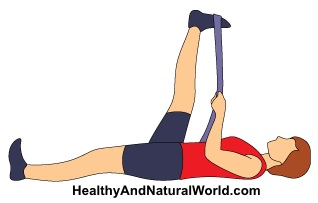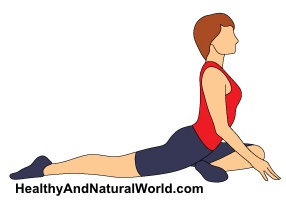Find The Cause Of Sciatica First
It’s important to get to the root of the problem. Sciatic pain is just a symptom – there is an underlying disorder that needs to be identified. You might need to seek advice from your doctor first and get a proper diagnosis before proceeding.
The two most common scenarios behind sciatica include:
- A herniated disc – the excruciating pain is caused by a bulging or ruptured disc that pinches or irritates the nearby nerve.
- Piriformis syndrome – this is a rare type of sciatica caused by irritation to the sciatic nerve by a muscle in the buttock called the piriformis. The piriformis can push the sciatic nerve against the tendons beneath it, which results in the familiar buttock and leg pain.
I wrote a number of extremely popular articles on how to outsmart sciatic pain and about the top 8 natural treatments for sciatic pain. This time I want to show you how yoga can help you with sciatic pain.
How Can Yoga Help With Sciatica?
If a herniated disc is the cause of your pain, you need to be very careful not to aggravate the condition and make it worse. Professional guidance is recommended when designing your exercise program. In some cases, yoga can help you manage the situation and can even reduce the herniation. The practice needs to progress from gentle poses to basic foundational asanas (yoga postures). Certain poses can align, strengthen and lengthen your lower back and offer gradual improvement.
If the culprit is a tight piriformis muscle, you need to work on stretching it. Again, be gentle and progress slowly. You don’t want to overwork piriformis and worsen the pain.
What follows is a selection of yoga poses that target the piriformis and can help you relieve sciatic pain.
Reclining big toe pose – Supta Padangusthasana
- Use an elastic strap to do this stretch and place it around the ball of your right foot.
- Straighten the right leg towards the ceiling while holding the strap.
- Stretch the right leg upwards and keep the foot flexed. As you do this, both sides of your butt should be pressed against the floor.
- Hold for 10 breaths.
- Lower the right leg slowly by first bending the right knee towards your chest and then placing the leg on the floor.
- Repeat on the left side.
Staff pose – Dandasana
This is the basic seated pose.
- Sit with your legs outstretched and your palms touching the floor by the sides of your body.
- Flex your feet back, so you give your legs a good stretch.
- Sit straight and make your spine long, as if you were pulled up by a string.
- Beginners can put some padding under the buttocks.
King pigeon pose – Eka Pada Rajakapotasana
This is the strongest of the piriformis stretches.
- Start on your hands and knees or from the ‘downward facing dog’ pose.
- Bring your right knee forward and out and put your right foot in line with the left hip. Your shin should be at 45o
- Release your left leg on the floor behind you and slowly slide it back while bringing your body forwards. When you reach the final position, the left toes are pressing down into the mat.
- Hold for a few breaths.
- Repeat on the left side.
- If you find the position too challenging, you can use a table to support yourself. Place your right leg up on a table, with the knee out and right foot in line with the left hip. Place your hands on the table for support and lean forward. Walk your left foot back.



